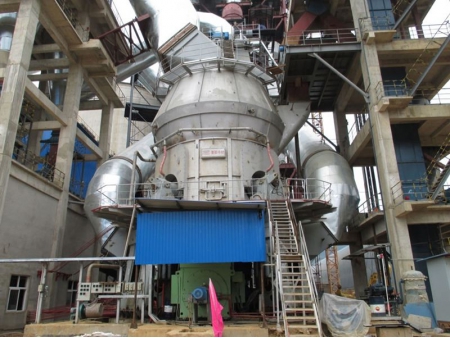Vertical Roller
SINOMALY produces cement raw material grinding mills in various specifications. These machines are suitable for grinding mill production lines with an output of 2500t/d, 3200t/d, 4000t/d, 5000t/d, 6000t/d and 8000t/d. The vertical grinding mill is utilized for the grinding of raw materials, mixed cement, and slag powder.
| Model | Main Motor Power(KW) | Capacity(t/h) | Plant Scale(t/d) |
| LRM36.4 | 1600~1800 | 180~200 | 2200 |
| 1800~2000 | 210~230 | 2500 | |
| 2240~2500 | 250~280 | 3200 | |
| 2500~2600 | 280~300 | 3200 | |
| 2800~3000 | 320~360 | 4500 | |
| 3150~3350 | 350~380 | 4500 | |
| 3800~4000 | 400~420 | 4500 | |
| 3800~4200 | 420~450 | 5000 | |
| 4000~4500 | 450~500 | 6000 | |
| 4800~5000 | 530~550 | 7200 | |
| 4800~5100 | 540~560 | 7500 |
Remarks: raw material moisture ≤8%, raw material granularity ≤80 mm is about 95%, product fineness R0.08≤12%, product moisture ≤0.5%
- Rotary feeder
- Separator
- Housing
- Grinding roller
- Rocker arm
- Grinding table
- Drive
- Tension device
- Mill stand
Grinding table design
The largest component of the vertical raw mill is the grinding table and it plays important roles in the overall performance of the vertical mill. The design of the grinding table revolves around the grinding capacity, grinding speed, and space setting. The grinding capacity of the vertical milling machine is directly related to the working diameter of the table. The rotating speed of the grinding table determines the output speed, but this needs to be adjusted as different materials have different speed requirements. Grinding speed depends largely on pressure, quantity, and size of the roller, as well as table diameter, rotation speed, material thickness, and more.
Grinding roller design
The grinding roller is mainly composed of a roller shaft, bearing, hub, roller sleeve. The lubrication system of the grinding roller lubricates and cools the bearing. The grinding rollers press the material and crush it on the grinding table. Under constant pressure, the shape and size of the grinding roller have a direct impact on the grinding efficiency of the material.
Rocker arm design
The rocker arm is a component connecting the grinding roller and the tension device. The pulling force produced by the hydraulic cylinder is transferred from the rocker arm to the grinding roller, so the rocker arm is the main stressed part in the whole pressing system, therefore, its design is directly related to the output and stability of the vertical mill.
Separator design
SINOMALY adopts the most advanced vortex plane sorting method to design the separator, making the powder selection efficiency high. The rotor adopts a low resistance structural design, which reduces the running resistance of the vertical mill and saves energy. The gas-seal design is adopted for the rotor with adjustable height, which makes it convenient to install and adjust.
Rotary feeder design
The feeding device of the vertical milling machine adopts a rotary feeder, which has the advantages of a simple structure, stable operation and can feed continuously. The wear-resistant liner of the housing is machined metal, featuring high precision; the gap between the blade and the wear-resistant scraper is adjustable, both of which are wearing parts and can be replaced. Hot air can be entered from both sides of the housing to prevent the feeding valve from clogging.
Finite element analysis of key components
The rocker arm is a component connecting the grinding roller and the tension device. The pulling force produced by the hydraulic cylinder is transferred from the rocker arm to the grinding roller, so the rocker arm is the main stressed part in the whole pressing system, therefore, its design is directly related to the output and stability of the vertical mill.
- The roller can lift and fall automatically
- The grinding part is designed with horizontal grinding table and conical roller, which runs smoothly, with low abrasion and energy consumption
- The abrasion of the sleeve and the grinding table liner has little effect on output in later stages, and the yield reduction is less than 5%. Moreover, it is easy to repair or replace the liner and sleeve at any time.
- The drying capacity of the vertical mill is strong, and the waste heat of the kiln can be used to dry the raw materials with a moisture content of 8% or higher.
- The air ring area, the air ring angle and the height of the dam ring can be adjusted according to the working conditions.
- Detection devices are equipped for mechanical, electrical limit and material layers to improve safety.
- The large-diameter cartridge valve is employed to ensure large oil pump flow and fast hydraulic action. For ultra-fine materials with high-flow, the operator can reduce the water spray to reduce heat consumption.
- The grinding roller is sealed by dustproof felt and oil, which can effectively prevent dust from entering the bearing.
- The roll sleeve and the grinding table's liner can be re-soldered on the working line and reused, which can reduce the cost of replacing consumable parts.
- A turning device is equipped on the vertical mill, which can turn the grinding roller out of the machine, thus it can be maintained easily.
- 3200t/d grinding mill production line——LRM40.4 vertical mill
- 5000t/d grinding mill production line——LRM38.4 vertical mill with dual system
- 2500t/d grinding mill production line——LRM38.4 vertical mill
- 7200t/d grinding mill production line——LRM41.4 vertical mill with dual system




